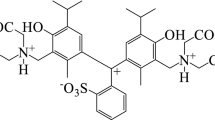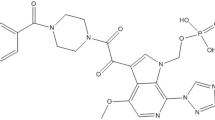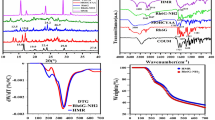Abstract
METHYLENE blue dissolves in water and common organic solvents to give blue solutions absorbing light of wavelength near 660 mµ, for example 657 mµ in n-butanol (Fig. 1, curve a). A faint band at 480 mµ. is just detectable, but can be seen more readily if the molar extinction coefficients are plotted on a logarithmic scale (ref. 1). Wine-red solutions have been obtained here when the dye is dissolved in simple aliphatic amines dried over potassium hydroxide pellets for several days and redistilled more than once if necessary. The blue colour of the dye could be restored by adding either water or ethanol; standing for several days in the amine, however, appeared to bring about some chemical change in the dye. Although the dye dissolved immediately in the hot amines the use of elevated temperatures was considered undesirable. Instead the dye was dispersed by ultrasonic vibration in the cold amine and then allowed to stand for several hours (usually overnight) to pass into solution. A typical spectrum is that in n-hexylamine shown in Fig. 1, curve b, and the special data for other systems are given in Table 1. The solutions were quite red, even when saturated; at the boiling point of the amine there was no trace of the blue form. This latter fact appears to eliminate dye–dye association (see ref. 2) and interaction with chloride counter-ions (see ref. 3) as important factors. The existence of the red form clearly depends on the strongly basic character of the amine. Thus the dye is red in primary, secondary (open-chain and cyclic), and tertiary aliphatic amines, all of which are strong bases with pKb values in the range 2.8–3.4, and in the araliphatic amine benzylamine (pKb = 4.7); aniline, pyridine, quinoline, and indeed all the other common organic solvents in which the dye is soluble are only weakly basic (pKb ≥ 8.9) and in them it is blue.
This is a preview of subscription content, access via your institution
Access options
Subscribe to this journal
Receive 51 print issues and online access
$199.00 per year
only $3.90 per issue
Buy this article
- Purchase on Springer Link
- Instant access to full article PDF
Prices may be subject to local taxes which are calculated during checkout
Similar content being viewed by others
References
Dähne, S., Z. Physik. Chem., 220, 187 (1962).
Rabinowitch, E., and Epstein, L. F., J. Amer. Chem. Soc., 63, 69 (1941).
McKay, R. B., and Hillson, P. J., Trans. Faraday Soc., 61, 1800 (1965).
Dähne, S., and Stanko, H., Naturwiss., 50, 328 (1963).
Liesegang, R. E., Kolloid-Z., 45, 370 (1928). Michaelis, L., and Granick, S., J. Amer. Chem. Soc., 67, 1212 (1945). Anderson, S., J. Opt. Soc. Amer., 39, 49 (1949).
Lewis, G. N., Goldschmid, O., Magel, T. T., and Bigeleisen, J., J. Amer. Chem. Soc., 65, 1150 (1943).
Brooker, L. G. S., and Sprague, R. H., J. Amer. Chem. Soc., 63, 3203 (1941); 67, 1869 (1945). Brooker, L. G. S., et al., 67, 1875 (1945). Brooker, L. G. S., Sprague, R. H., and Cressman, H. W. J., 67, 1889 (1945).
Brooker, L. G. S., Keyes, G. H., and Heseltine, D. W., J. Amer. Chem. Soc., 73, 5350 (1951).
Schwarzenbach, G., Brandenberger, M., Ott, G. H., and Hagger, O., Helv. Chim. Acta, 20, 490 (1937). Mohler, H., Forster, H., and Schwarzenbach, G., 20, 654 (1937). Schwarzenbach, G., Z. Electrochem., 47, 40 (1941).
Lewis, G. N., and Calvin, M., Chem. Rev., 25, 273 (1939).
Compare with Pauling, L., in Organic Chemistry, edit. by Gilman, H., 2, chap. 26 (Wiley, New York, and Chapman and Hall, London, 1943).
Lewis, G. N., J. Amer. Chem. Soc., 67, 770 (1945).
Buttgereit, G., and Scheibe, G., Ber. Bunsenges. Physik. Chem., 69, 301 (1965).
Author information
Authors and Affiliations
Rights and permissions
About this article
Cite this article
MCKAY, R. Red Forms of Methylene Blue. Nature 210, 296–297 (1966). https://doi.org/10.1038/210296a0
Published:
Issue Date:
DOI: https://doi.org/10.1038/210296a0
This article is cited by
-
Kinetic and thermodynamic study of methylene blue adsorption onto chitosan: insights about metachromasy occurrence on wastewater remediation
Energy, Ecology and Environment (2019)
-
Electronic absorption spectroscopic studies on the red form of methylene blue ion
Proceedings / Indian Academy of Sciences (1980)
-
Self-oxidation of Methylene Blue
Nature (1968)
Comments
By submitting a comment you agree to abide by our Terms and Community Guidelines. If you find something abusive or that does not comply with our terms or guidelines please flag it as inappropriate.



